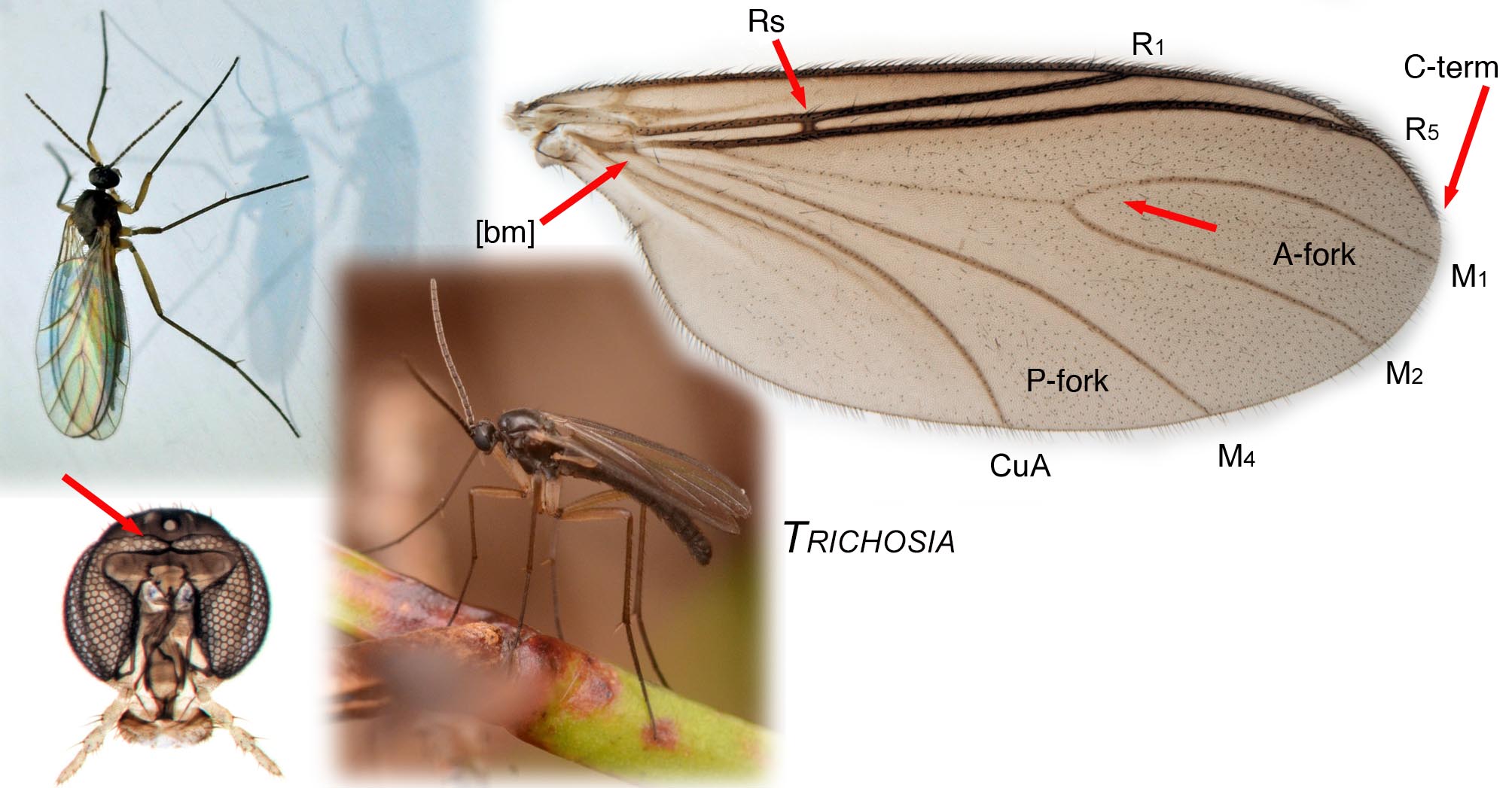Pictographic guide to the Nordic families of Bibionomorpha (Diptera)
If you wonder whether you have an adult fungus gnat or not in front of you, the pictographic guide below should lead you to the right family among the Nordic species of the infraorder Bibionomorpha. For a more comprehensive key to all European Diptera families I recommend to use Oosterbroeck (2006). Each family is here illustrated with one or a few typical adult members showing their habitus and wing venation. A short differential diagnosis gives a few key characters that also are highlighted with red arrows on the images. Emphasis is put on segregating those families that may look like a fungus gnat and how to separate the fungus gnat families.
By Jostein Kjaerandsen, Tromsø University Museum - Version 1, 10 april 2015
Fungus gnats are a rich assemblage of nematocerous flies (Diptera, Nematocera) placed in the infraorder Bibionomorpha and superfamily Sciaroidea, currently divided into eight families (Blagoderov and Grimaldi 2004). Five of these families (Bolitophilidae, Diadocidiidae, Ditomyiidae, Keroplatidae and Mycetophilidae) are infromally called ‘fungus gnats’ by most European authors. Species in these families are morphologically closely related and the group is also ecologically uniform.
Adults of the North European species of fungus gnats can largely be identified using Hutson et al. (1980) and Zaitzev (1994) − Bolitophilidae, Diadocidiidae, Ditomyiidae, Keroplatidae, and Mycetophilidae in part (Mycomyiinae, Sciophilinae, Gnoristinae and Leiinae), and Zaitzev (2003) – Mycetophilidae in part (Mycetophilinae and Manotinae). However, since many new taxa are added, and corrections, synonyms and revisions continually published, one needs a complete set of the fragmented taxonomic literature to cover all the species. A good source for obtaining most important literature on the Sciaroidea is the ViBrant/Scratchpad module Fungus Gnats Online.
Species identification of fungus gnats based on morphological examination of larvae is currently almost impossible because the larvae seemingly lack unique morphological characteristics, but a steadily growing library of DNA barcodes may soon change that.
FAMILY Anisopodidae Knab, 1912
Medium sized smoothly rounded flies with short palpi and without conspicuous bristles on legs. The partly spotted wings have a characteristic primitive wing venation where R2+3 arise before crossvein r-m and four branches of media, M1-M4, arise from a central discoidal cell closed by cross vein m-m. In Europe we have some 10 species, all in one genus Sylvicola (but see comment under Mycetobiidae below). By habitus with its circular outstanding head they are superficially similar to some Mycetophilidae, particularly of the genus Leia, but Leia and most Mycetophilidae have conspicuous long bristles on their legs and very different wing venation.
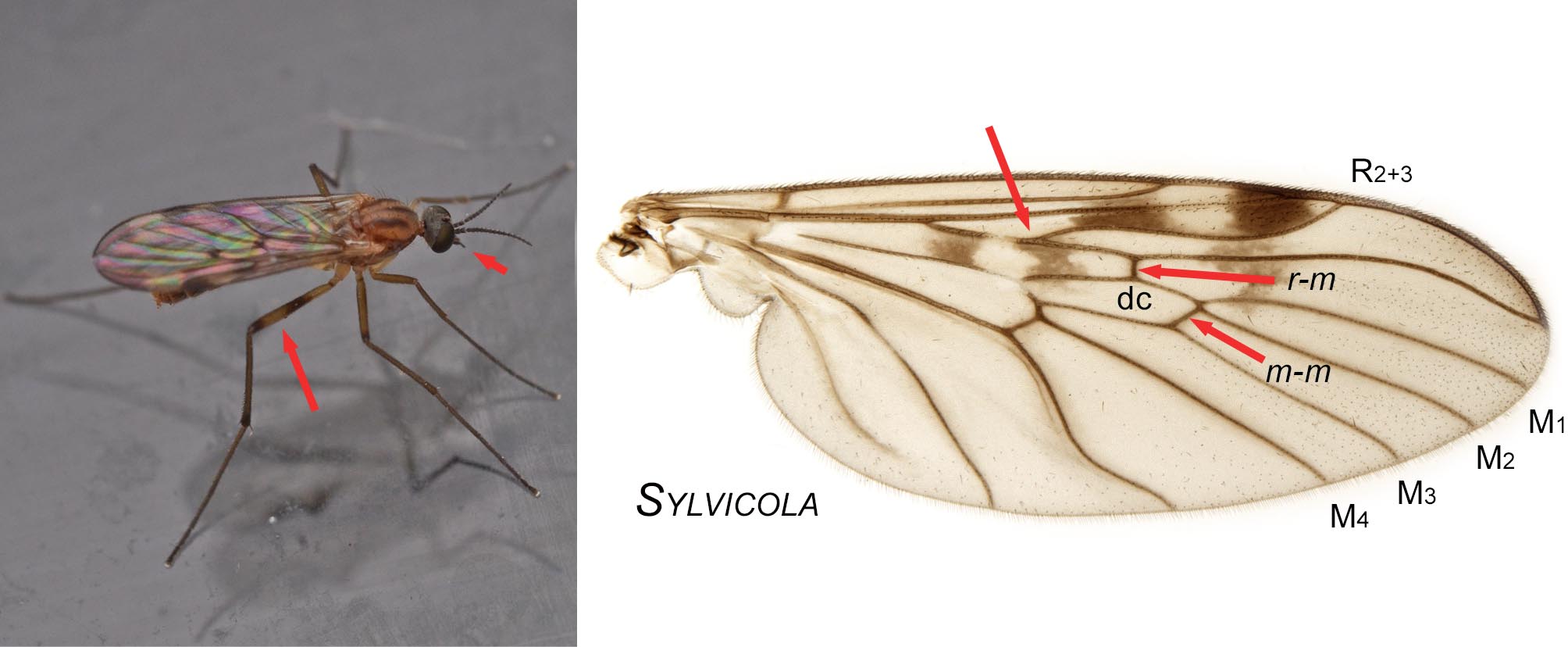
FAMILY Mycetobiidae Crampton, 1924
This small family includes four small (4-7 mm) dark species in Europe. Like the Anisopodidae they have short palpi and are without conspicuous bristles on their pale legs. Males have quite large terminalia. Although placed together with and sometimes considered to be a part of the Anisopodidae, the Mycetobiidae stands out from the former by lacking discoidal cell as well as the veins M3 and m-m in their wings. The rather long coxae and the large male terminala may make them superficially look more like some fungus gnats, but the characteristic wing venation with a long R2+3 originating slightly before crossvein r-m reveals the close relationship to the Anisopodidae.
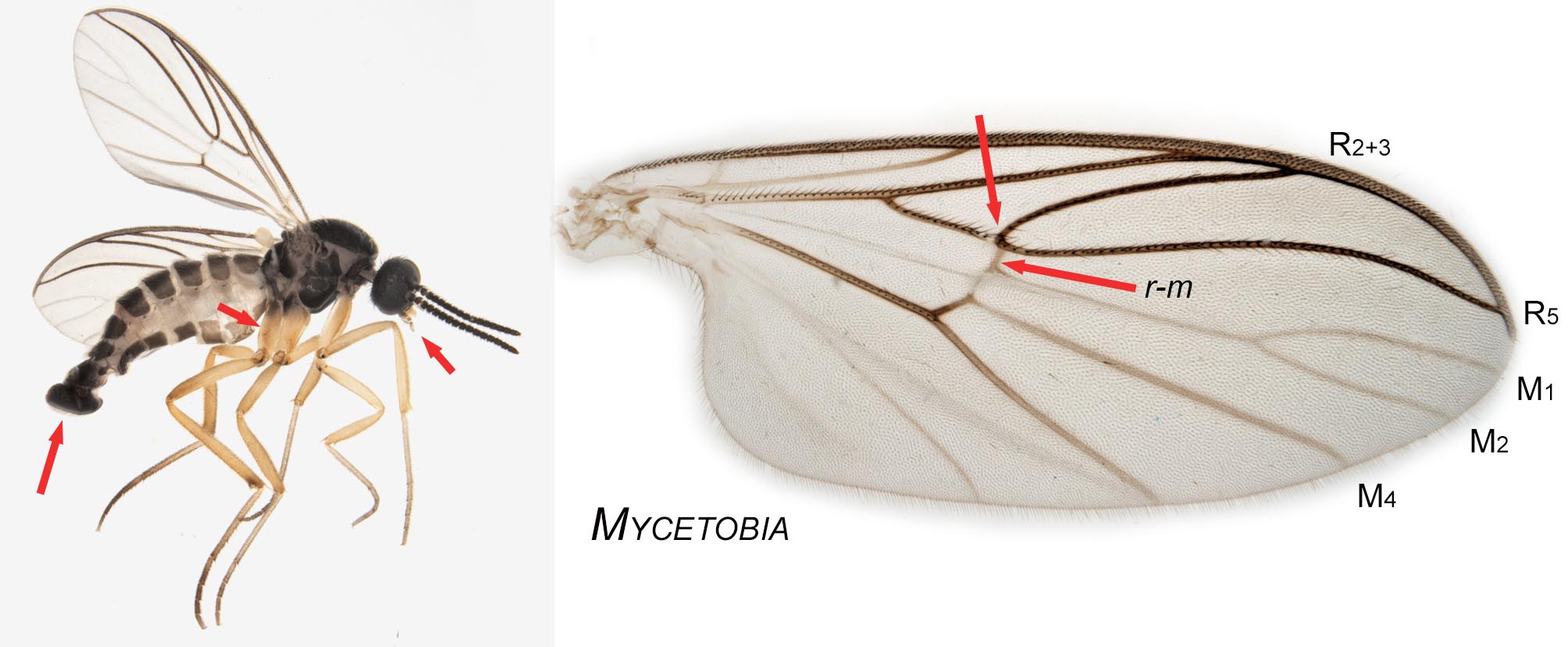
FAMILY Canthyloscelididae Enderlein, 1912
Stout medium sized flies with short and stout legs, hind femur swollen and hind tibia characteristically curved. Their wings are tinged in brown with dark subcostal and apical shades. Their wing venation is characteristic with crossvein r-m replaced by a long fusion of M1+2 and Radius, Radius basally absent. Only two very similar and rarely encountered species occur in Europe including the Nordic region, here represented with a female Hyperoscelis veternosa Mamaev & Krivosheina, 1986 from northern Sweden.
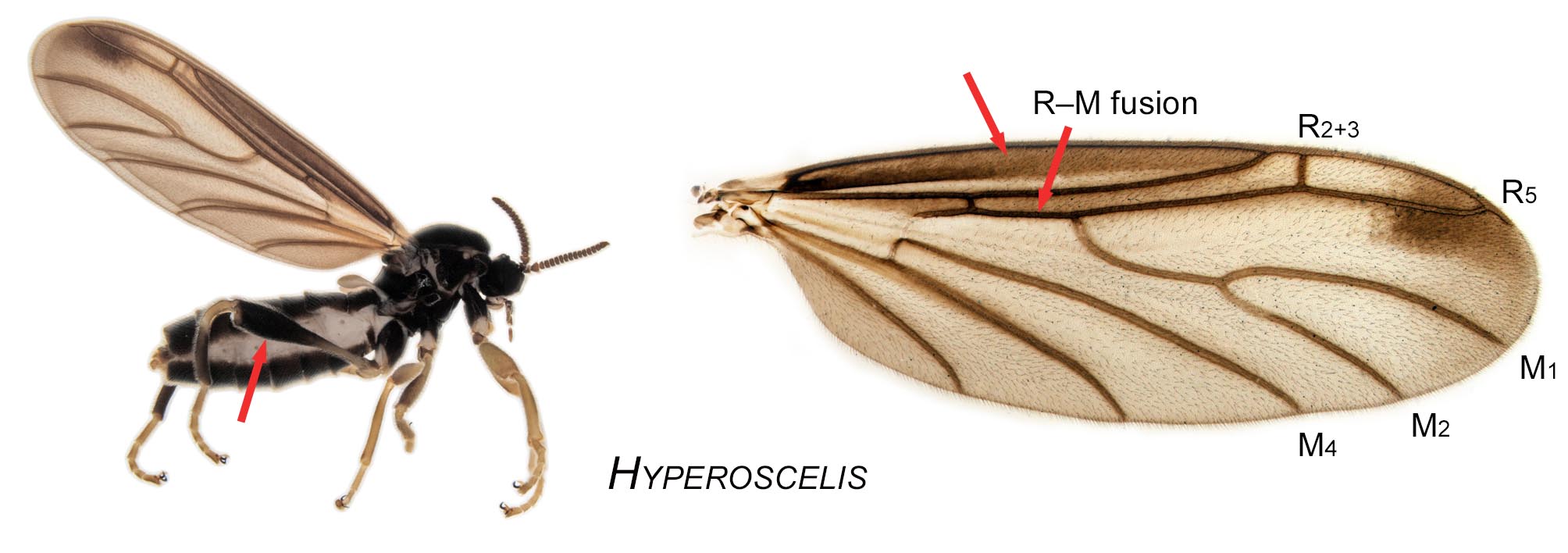
FAMILY Synneuridae Rohdendorf, 1959
While often considered to be a part of the Canthyloscelididae, this small family with only one widespread but quite rare species in Europe, Synneuron annulipes Lundström, 1910, has a rather different wing venation. Both the R2+3 vein and the crossvein r-m are replaced by fusions, the latter forms a characteristic x-shaped radial sector in the front of the wing. The veins M3 and M4 can be traced all the way back to the greater basal cell, gb. By habitus it looks much like a small Hyperoscelis, but with less thickened hind femur.

FAMILY Scatopsidae Newman, 1834
Small compact flies with short untapered antennae, only one-segmented palpi and characteristic wing venation where only the costa, C, and the radial sector, R, is sclerotized and form a prominent closed cell frame anteriorly on the wing. Some 100 species in Europe are exemplified here with a male Scatopse notata L. from Sweden.

FAMILY Pachyneuridae Schiner, 1864
In Europe this small family is represented with only one characteristic, large (10-13 mm) and archetypical species. Pachyneura fasciata Zetterstedt, 1838 is rare and confined to boreal forests in the taiga. It is looking much like a huge fungus gnat, but can be distinguished by the radius, R, forking into four branches where R2+3 and R4 forms a short fork. The stigma is much more distinct than in the somewhat similar wings of Bolitophilidae. The thick and strongly sclerotized veins gave rise to the Latin name of the genus and family.
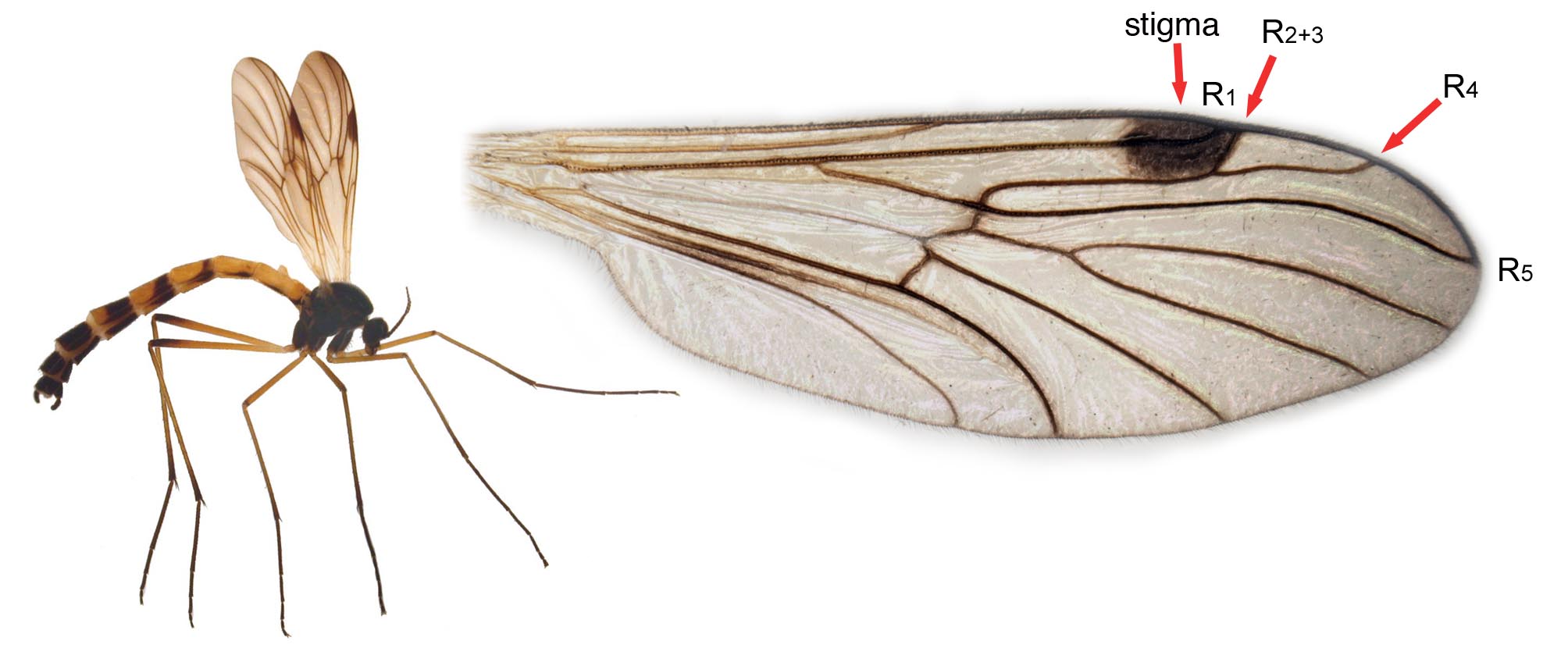
FAMILY Bibionidae Fleming, 1821
Small to large (up to 15 mm) stout flies, usually with dense pubescence on body and legs. The antennae are short, usually not longer than the stout palps. Males have large holoptic, hairy eyes while females often have small eyes and narrow, elongated head. The wings have a distinct stigma and weakly sclerotized veins beyond the radial sector. Vein m-m present, but the discoidal cell is open to the base of the wing. In Europe there are some 50 species in three genera (here the genus Pentheria is included although this is often placed in a separate family, the Pleciidae).
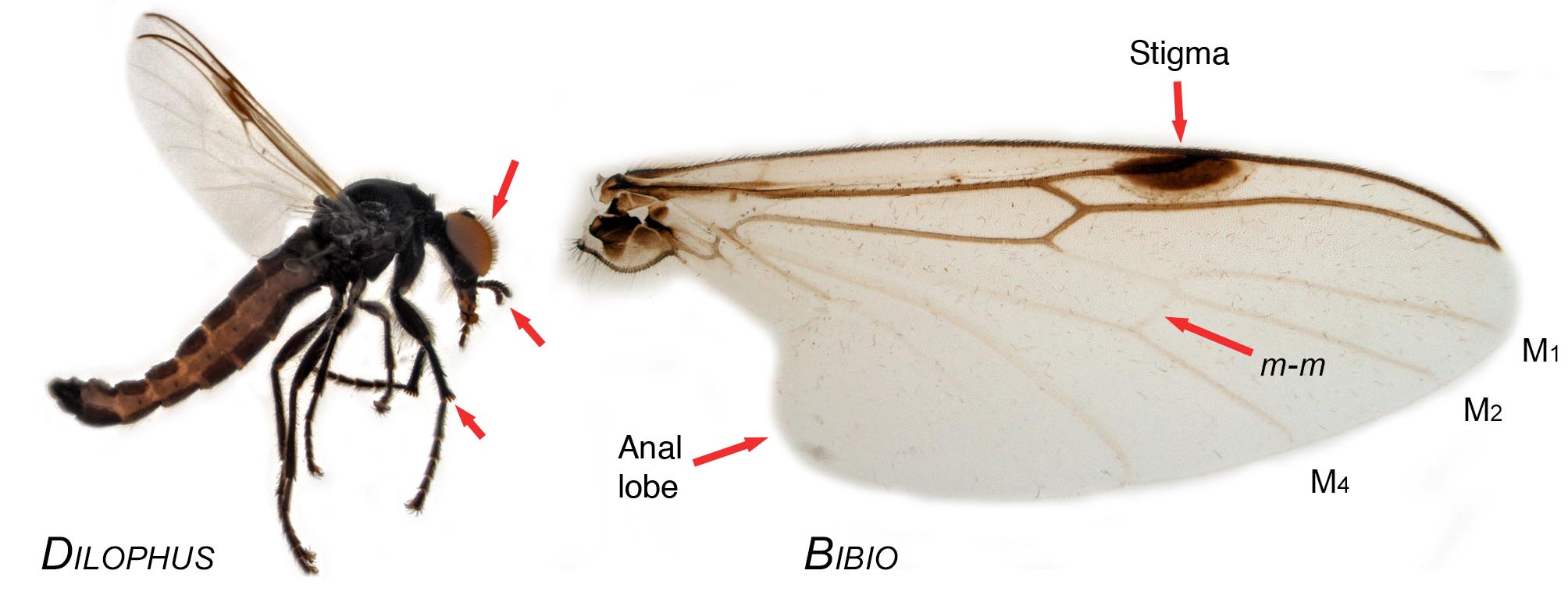
Superfamily Sciaroidea
The remaining families belongs to the superfamily Sciaroidea.
FAMILY Ditomyiidae Keilin, 1919
Medium sized (6-8 mm) yellowish brown, long-legged gnats with quite hairy wings. Their wing venation is characterized by a very short sc, a long R2+3 that is ending free and hence forming a third fork in front of the anterior fork (M1 + M2), and crossvein tb connected to the posterior fork (M4). In the Nordic region we have three species in two genera, where the genus Ditomyia is known only with a single early 1800 record of D. fasciata from Skåne (Sweden). The two species of the genus Symmerus are so far only recorded from southern parts of Scandinavia (north to Møre og Romsdal in Norway) but may turn up further north as well.
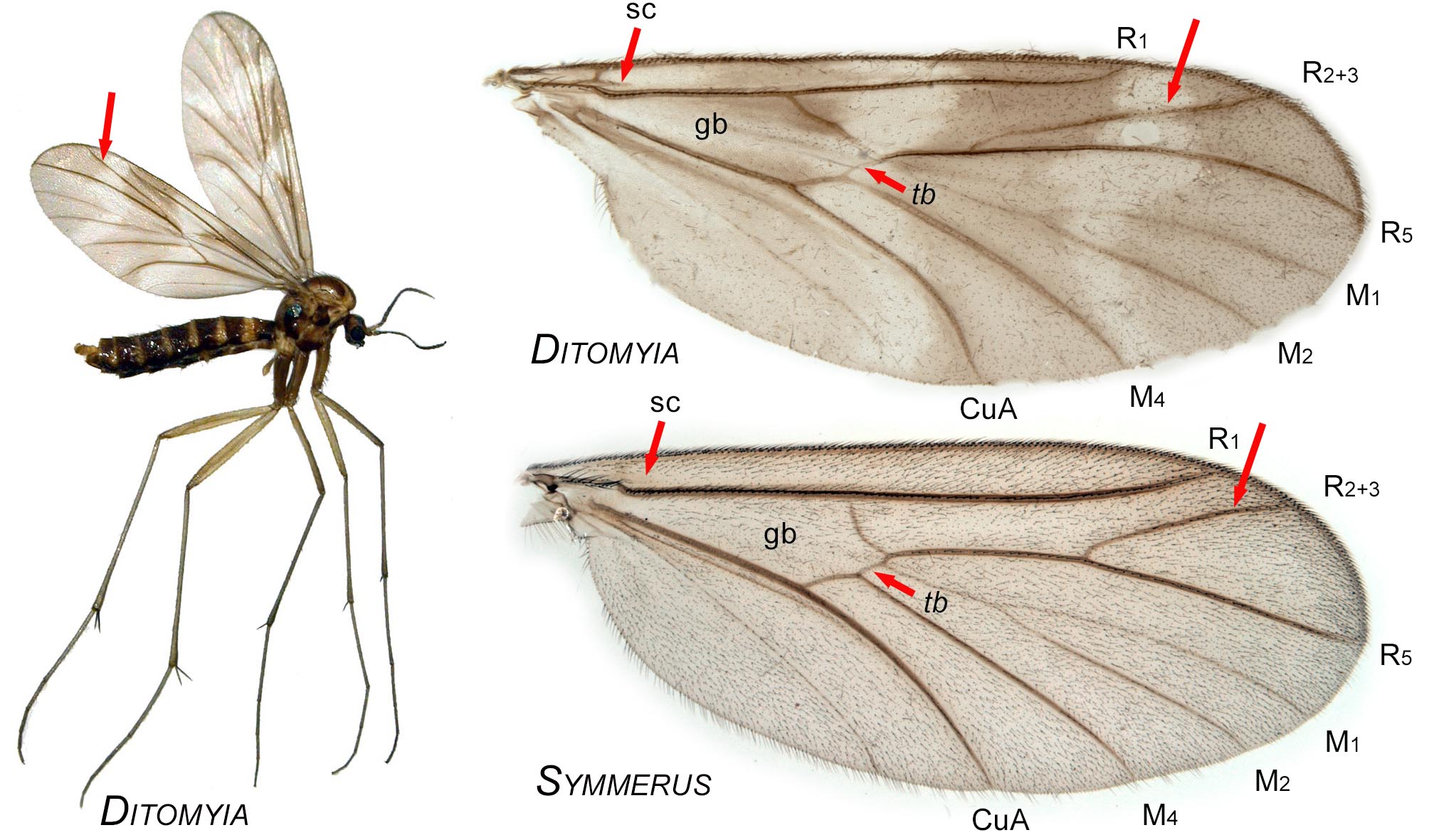
FAMILY Cecidomyiidae Newman, 1835
Minute to small, occasionally larger (0.5–3 mm, up to 9 mm) delicate flies, usually with long thin legs and a variable shaped, often with broad eye-bridge dorsofrontally on the head. The characters that uniquely separate them from the rest of the Sciaroidea includes legs without spurs, flagellar segments of antennae with basal thick node and distal thin neck (loose pearl-band), and that the Costa vein continues all around the wing, usually with a short break near the tip of the wing only. The males often have long and conspicuously plumose antennae made up of rings of sensillae on the flagellar segments. These tiny flies can often be seen hanging from spider webs at the entrance of damp dark clefts and holes. The Cecidomyiidae is a megadiverse family with more than 6300 world species, currently divided into four subfamilies.
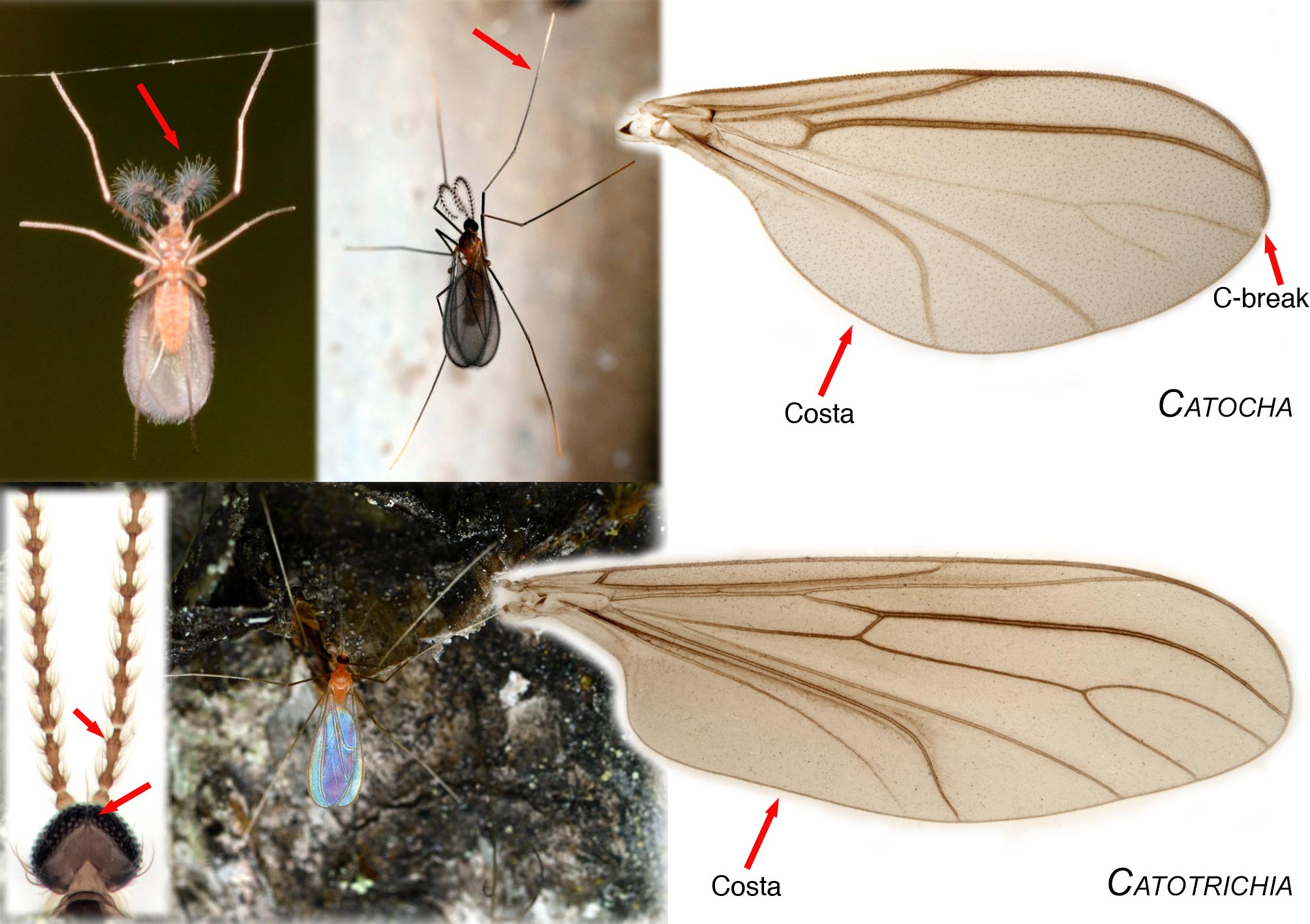
FAMILY Bolitophilidae Winnertz, 1863
Small to medium sized (4-8 mm) very slender gnats with long, thin legs and long antennae. Their wing venation is again characteristic for the family with small and retracted bm cell (much smaller than cell br), long subcosta (sc) ending in Costa and a faint stigma present. All recent species of this family are placed in one genus, Bolitophila, of which two subgenera are distinguished on whether the short vein R2+3 ends in R1 inside the stigma (subgenus Bolitophila) or in Costa beyond R1 (subgenus Cliopisa). The Bolitophilidae is mainly Holarctic in distribution and nearly half (31) of the 64 world species are known from the Nordic region.
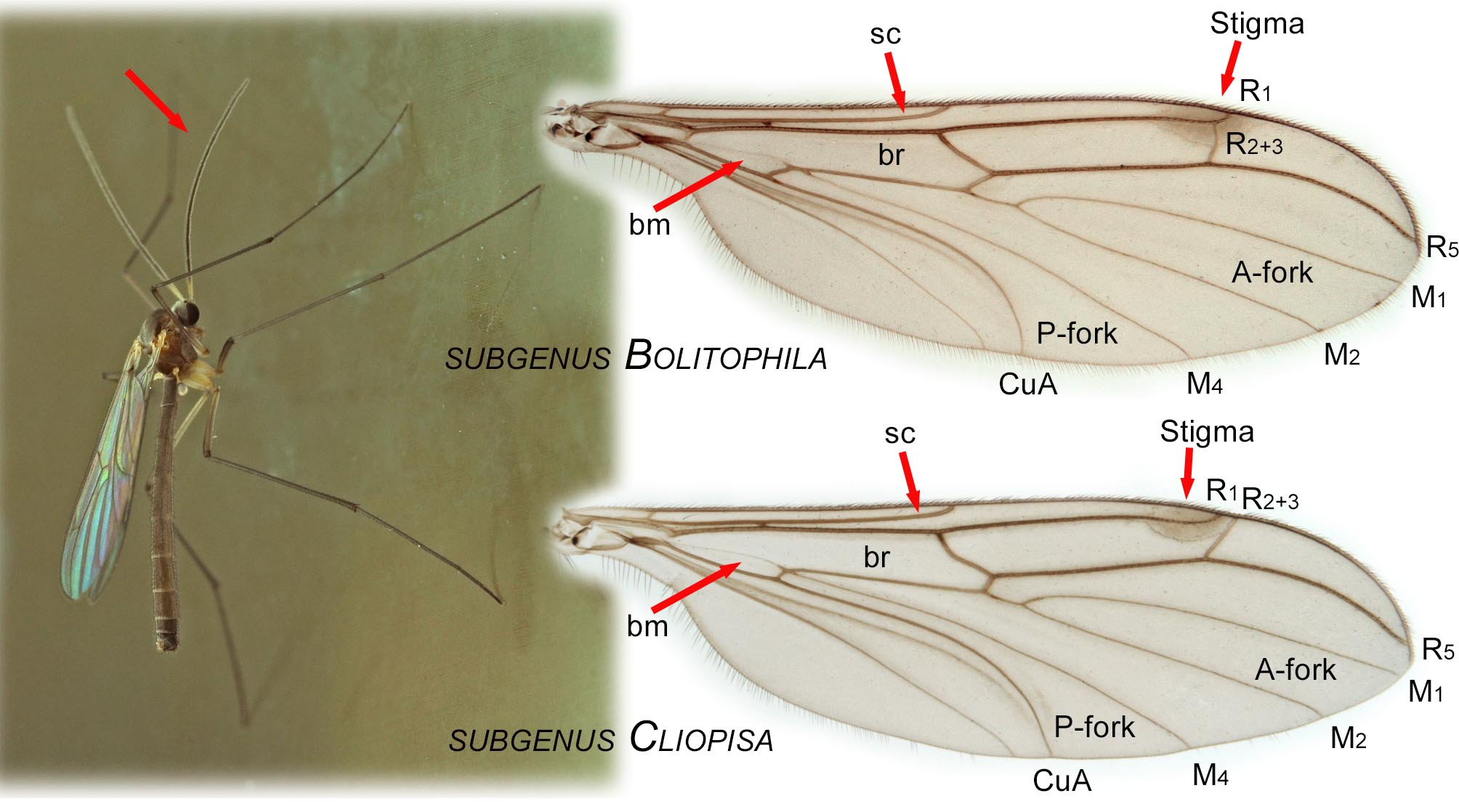
FAMILY Keroplatidae Rondani, 1856
Medium to very large (4-15 mm), both slender and stout, fungus gnats all having a quite uniform wing venation where the r-m crossvein is replaced by a short R-M fusion. The family includes a large, wasp mimicking species Keroplatus tipuloides and a few other quite stout species having laterally flattened antennae (tribe Keroplatini). Some species have prolonged proboscis. The common and species rich genus Macrocera (subfamily Macrocerinae) has characteristic long antennae (up to 4 times the body length) and the posterior fork (wing veins M1 and CuA) are slightly converging in the basal part before widening. This family is more diverse in the tropics than in the Holarctic region, and is represented with some 16 genera and 110 species in Europe. Of these, 63 are recorded in the Nordic region, many with a southern distribution.
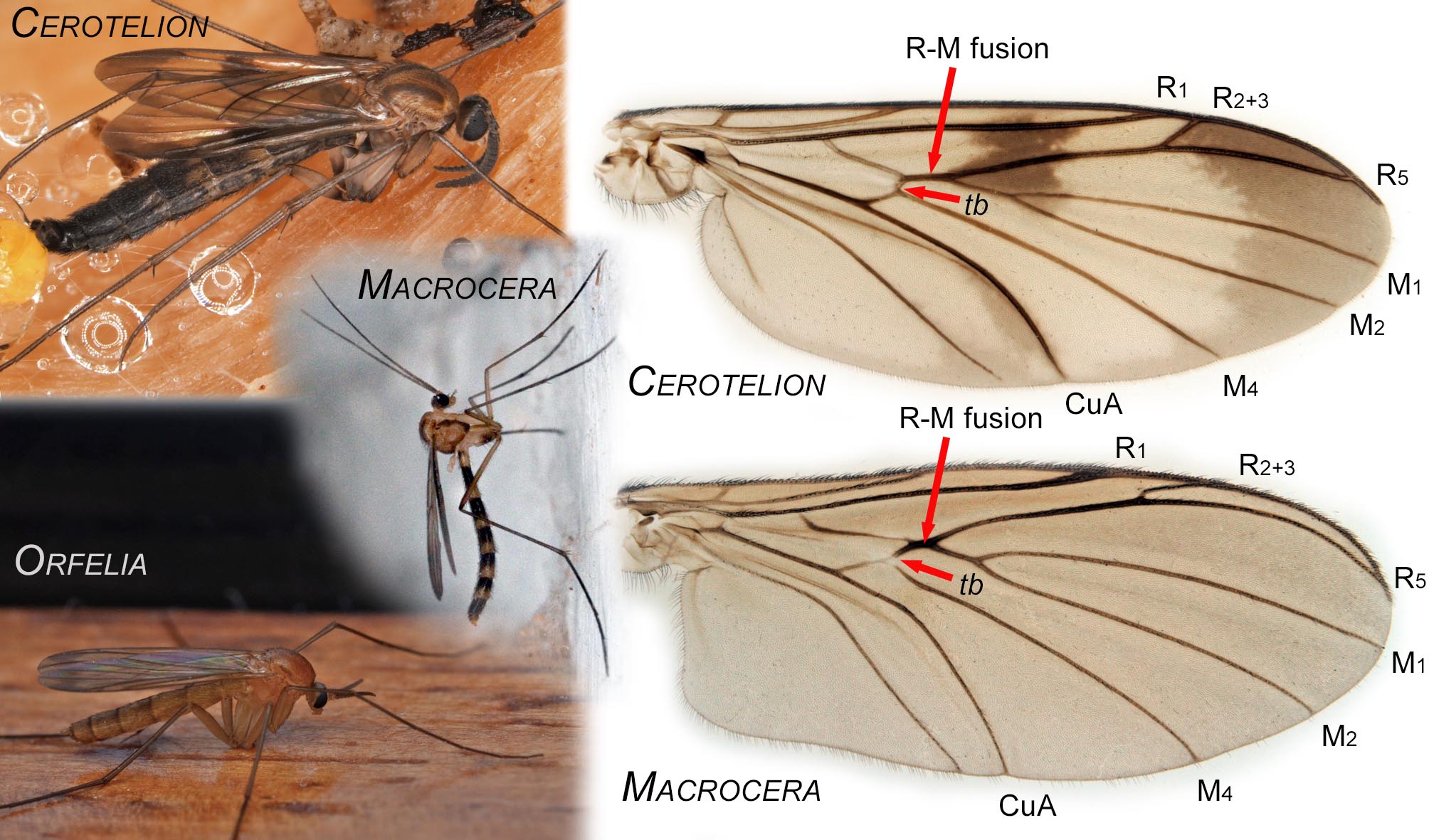
FAMILY Mycetophilidae Newman, 1834
This is the "true fungus gnats", a large and morphologically diverse family comprizing the majority of the species in the Nordic region. Their body shape range from tiny to large (2-8, some up to 15 mm) and very slender to stout. They are usually coloured with stripes in yellow and blackish brown, but may be all ochraceous or all black. The family are characterized by always having long, stout coxae placed tight together to form a very high, vaulted (humped backed ) thorax. They all have long spurs apically on tibiae, and often quite spiny legs with rows of stour bristles. The wing venation is quite variable and often used to diagnose genera.
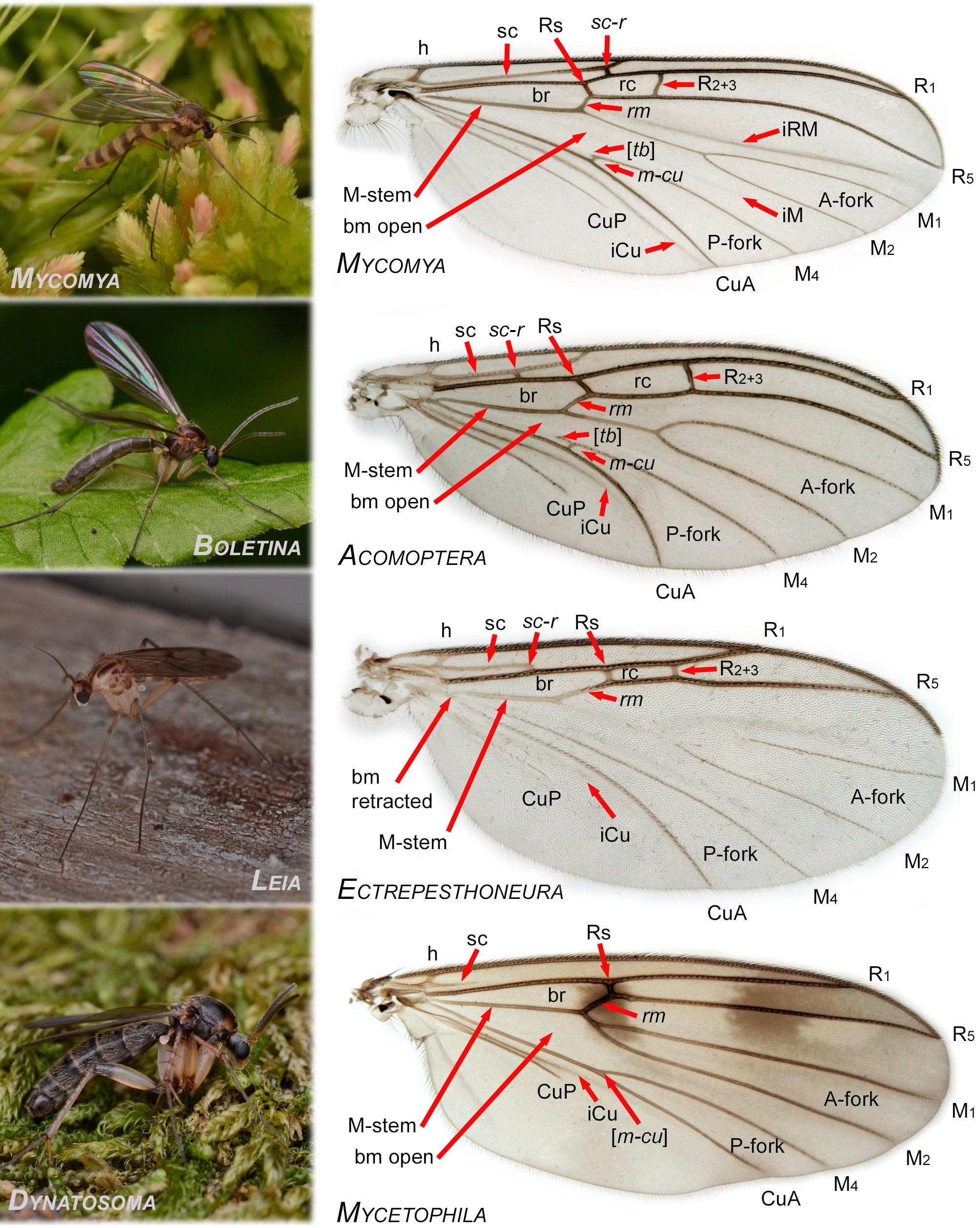
INSERTA SEDIS Sciarosoma nigriclava (Strobl, 1898)
This is the single Nordic species of fungus gnats that not yet has been formally assigned to a family (Sevcik et al. 2016). It displays characters somewhat in between the Sciaridae (wing venation with sessile posterior fork, cell bm absent) and the rest of the fungus gnats (separate eyes, complex male genitalia). The long and curved R5 ending together with Costa at tip of wing is also characteristic.

FAMILY Diadocidiidae Winnertz, 1964
Small (3-5 mm) yellowish and delicate, rather short-legged gnats with pale brown to gray and quite hairy wings. Their wing venation is unique with all the crossveins (r-m, tb, m-cu) in line at the basal third of the wing and with vein M4 strait. All recent species of the family are placed in one genus, Diadocidia, and there are only five described species in the Nordic region.

FAMILY Sciaridae Billberg, 1820
The black fungus gnats, family Sciaridae, are delicate small (1-6, occasionally up to 10 mm), usually dark coloured flies with rather uniform wing venation where Costa ends near the tip of the wing. The characters that separate them from the rest of the Sciaroidea includes the combination of nearly always presence of a narrow eye-bridge on the head above the antennal sockets (absent in a few minute, partly wingless forms), the short Rs being the only cross-vein beyond the base of the wing, a sessile posterior fork where the cell bm is completely retracted and vestigial, and anterior fork rounded basally and more or less bell-shaped. The black fungus gnats are yet another megadiverse family, perhaps with some 500 Nordic species but still rather poorly known. Some of the larger species like that of Trichosia below are superficially quite similar to small species of Boletina (Mycetophilidae), but can be distinguished by all the characters mentioned above.
